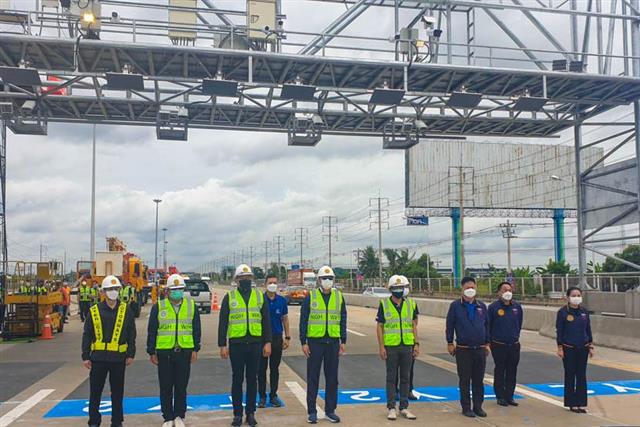It is well known that highways are the lifeblood of metropolitan transportation. To increase the speed of highways and the convenience of road users, Taiwan entrusted Far Eastern Electronic Toll Collection (FETC), a subsidiary of the Far Eastern Group, with the operation of the nation's highway electronic toll collection (ETC) system through a build-operate-transfer (BOT) model in 2004. More commonly known as just the "ETC" in Taiwan, the system has weathered through its early difficulties and controversies 17 years ago to become a model to replicate for countries around the globe, says FETC International vice president and chief technology officer, Richard Wu. FETC International is now planning to share its successful ETC model and experience in Taiwan to foreign markets.
Taiwan's ETC system has undergone many changes, and FETC has been constantly adjusting its approach according to the feedback from the public. Wu explains that back in 2003, the infrared-based systems were both expensive and had poor detection, resulting in a poor public adoption rate. Furthermore, the technologies of the devices were held by foreign brands, depriving Taiwan of the possibility to become technologically independent down the line. In 2008, FETC finally decided to replace the foreign system and switch to an RFID-based system that relied on an open standard. The company then made further improvements by integrating what they had learned over the five years since the initial launch to ensure that the new ETC system could better match public expectations.
At that time, most electronic toll collection systems in other countries still had manual toll stations in the mix, while Taiwan had already implemented all electronic toll collection, and even went from flat-rate tolling scheme to a distance-based pay-as-you-go tolling system (otherwise known as the multilane free flow system, MLFF) in 2014. Toll stations were removed and replaced with RFID readers, Lidar and cameras installed on gantries along the highway, resulting in much faster vehicle speeds. Consequently, RFID readers needed to be able to accurately exchange information with the miniature eTags on each passing vehicle. This difficulty is only further increased by the fact that vehicles may also switch lanes as they pass through. However, these obstacles were ultimately overcome through Taiwanese technological ingenuity.
Since the launch of the RFID Tag electronic toll collection in 2014, the Taiwan ETC system has delivered exceptional results. Not only was it the first system to transition from charging by toll gates to using through an open road electronic toll collection system, but it also has a very high market penetration rate. Nearly 7.6 million of the 8.2 million vehicles in Taiwan currently have an eTag installed, and the overall eTag utilization has passed 94%. The system has a total highway network length of 926 kilometers, a tolling accuracy rate accuracy rate of 99.9998%, and a successful toll collection rate of 99.97%, making it the most advanced toll collection system in the world.
Wu further points out that the first and most difficult requirement in setting up a smart transportation system is to have a sufficiently large database. Luckily, the Taiwan ETC system collects up to 16 million transactions every day, which is a number made even more impressive due to daily accumulation over the years. These data are now being used to analyze the traffic flow on the highway, for example, by calculating the speed of traffic in lanes to provide drivers with accurate travel time estimates. In the future, the data can be further expanded to be used for parking and law enforcement purposes, or for managing border vehicles, port container trucks, overweight vehicles, dangerous vehicles, etc.
Taiwan's successful ETC implementation has made it the target of emulations from various countries in recent years. To better expand to other markets, FETC established FETC International in 2017 as a dedicated subsidiary to handle related operations. Wu mentions that the services of FETC International are quite diversified, ranging from consulting services, total solutions, assisting local system integrators with obtaining bids, or even with providing the subsequent implementation, operation and maintenance services.
But he explains that systems for foreign markets are distinctly different from the one in Taiwan, as different customs and cultural expectations about driving render adjustments to the system necessary in order to meet local expectations. After spending some time adapting to foreign markets, FETC International now has some preliminary results to show. The company has acquired the bid for the highway toll collection system in Thailand, while in talk with the Philippines and Malaysia. India is also experimenting with the system and may further adopt the system on a wider scale in the future should the proof of concept prove successful. On October 1, FETC International will be participating in Taiwan Excellence's Smart Upgrade with AI Webinar, sharing its AI vehicle recognition application in the first MLFF POC (so called M-Flow) in Thailand. To learn more about the webinar please visit the event website.
Wu says that FETC International plans to start with a modest growth strategy at the beginning targeting Southeast Asia then later expand to other markets. He believes that the Taiwan ETC system is the world-leading highway electronic toll collection system, so it will not be difficult to bring the technology and experience outside the country. In the future, FETC International will continue to develop the relevant technologies and adjust its structure accordingly to expand its presence in foreign markets.

Senior officials from Ministry of Transport, Thailand and Freeway Bureau, MOTC, Taiwan visit the M-Flow's installment and testing.
Photo: FETC

Smart Upgrade with AI webinar
Photo: TAITRA







